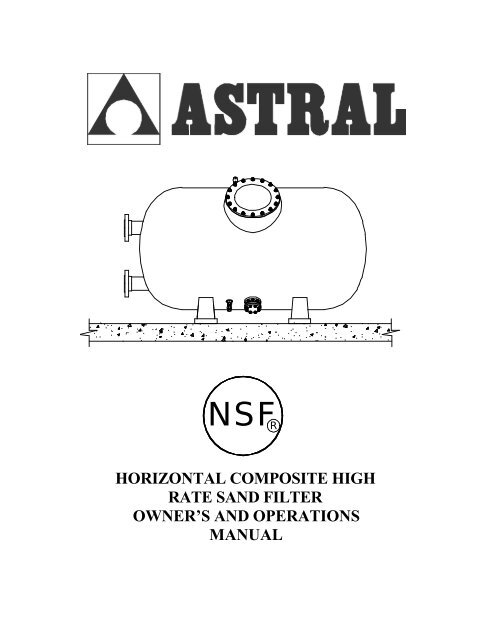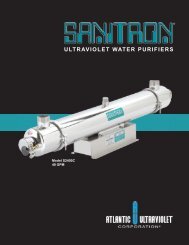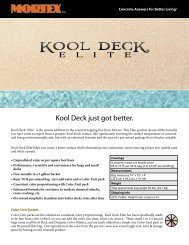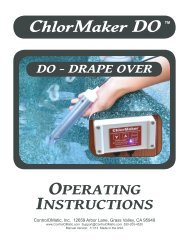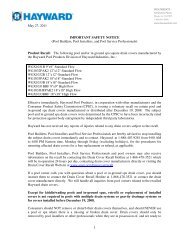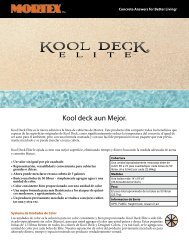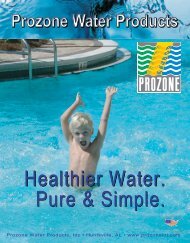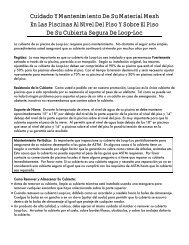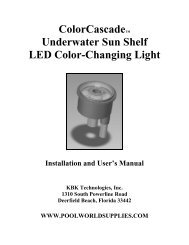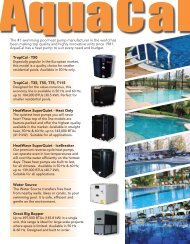Horizontal Sand Filter Brochure
Horizontal Sand Filter Brochure
Horizontal Sand Filter Brochure
You also want an ePaper? Increase the reach of your titles
YUMPU automatically turns print PDFs into web optimized ePapers that Google loves.
NSF R<br />
HORIZONTAL COMPOSITE HIGH<br />
RATE SAND FILTER<br />
OWNER’S AND OPERATIONS<br />
MANUAL
TABLE OF CONTENTS<br />
1. General<br />
1.1 Swimming pool filters<br />
1.2 Miami-Tank filters<br />
1.3 Selection of filters and installation<br />
1.3.1 <strong>Filter</strong> characteristics<br />
1.3.2 Installation characteristics<br />
2. Characteristics and dimensions<br />
2.1 Dimensions and media requirements<br />
2.2 Single filter system<br />
2.3 Dual filter system<br />
3. Installation<br />
3.1 General installation notes<br />
3.2 <strong>Filter</strong> installation<br />
3.3 Valve manifold and support installation<br />
3.4 Installation of the pressure gauges<br />
3.5 Testing of filter<br />
3.6 Installation of the media<br />
4. Normal operation<br />
4.1 Filtration<br />
4.2 Backwash<br />
4.3 Rinse<br />
4.4 Empty<br />
4.5 Close/Isolate<br />
4.6 Valve manifold table of operation<br />
5. Changing of the media<br />
6. Other recommendations<br />
7. Graph of filter head loss curve<br />
8. Replacement part drawings and numbers<br />
9. Warranty
1. General<br />
1.1 Swimming Pool <strong>Filter</strong>s<br />
<strong>Filter</strong>s are, without a doubt, the most important accessory used in the treatment of swimming pool water.<br />
Their purpose is to eliminate suspended particles from the circulating water, thus improving the clarity of the<br />
water.<br />
The principle of operation consists of passing the swimming pool water through a bed of sand which will<br />
retain any particles that are suspended in the water.<br />
It should be kept in mind that the filtration system consists of a number of elements, such as metering equipment,<br />
pumps, pool shell fittings and pipe work which ensure the correct suction and return flows that will<br />
affect the resultant condition of the treated water.<br />
Normally each country (possibly each state) will have its own standards for public and private pools. It is<br />
the responsibility of the installer to be aware of these codes before designing, specifying or installing any<br />
piece of equipment for a swimming pool.<br />
The quality of filtration depends on various factors: the size and shape of the media, the media bed depth,<br />
characteristics of the media such as granular size, density etc. A most important parameter is the water filtration<br />
rate. Other factors affecting the selection of a filter are the materials used for its construction, the<br />
working temperature, and the working pressure.<br />
1.2 Fiberglass <strong>Filter</strong>s<br />
Manufactured from polyester resin and fiberglass, they are virtually corrosion-proof. The internal fittings<br />
(diffuser and lateral system) are manufactured from PVC and polypropylene. They are unaffected by salt<br />
water and are normally manufactured for a working pressure up to 50 psi and a maximum working temperature<br />
of 122° F.<br />
Depending on the filtration velocity, filters are classified into three groups:<br />
• SLOW RATE FILTERS: Filtration velocities 5 to 10 GPM per sq. ft.<br />
• MEDIUM RATE FILTERS: Filtration velocities 10 to 15 GPM per sq. ft.<br />
• HIGH RATE FILTERS: Filtration velocities in excess of 15 GPM per sq. ft.<br />
For good filtration results, we recommend that filtration velocities of 15 GPM per sq. ft. are not exceeded,<br />
bearing in mind that the filtration velocity is dependent on the granular size of the media and the bed depth.<br />
It is also important to check all state and local codes that pertain to water filtration for swimming pools.
1.3 Selection of filters and installation<br />
1.3.1 <strong>Filter</strong> Characteristics<br />
It is recommended that the filtration system should filter at least 50% of the water from the surface of the pool as<br />
well as 50% from the lower levels of suction. The maximum turnover time for a public pool should not exceed 4<br />
hours, and for semi-public pools 6 hours. In the case of pubic pools for children the turnover should not exceed<br />
1½ hours. The times will vary from state to state and all local and state codes must be satisfied when using any<br />
filtration system.<br />
Example :<br />
If we have a public pool with a capacity of 150,000 gallons we need a filter capable of filtering this water in 4<br />
hours:<br />
150,000 gal / 4 hours = 37,500 gal/hour or 625 GPM<br />
To obtain a high quality of water filtration we recommend that the filtration velocity should comply with the following:<br />
Water parks 10 GPM per sq. ft.<br />
Commercial Pools 15 GPM per sq. ft.<br />
625 GPM / 10 GPM per sq. ft. = 62.5 sq. ft. of filtration required<br />
Now chose the filter or filters that meet this requirement. Remember it is possible to add filters together to obtain<br />
the correct amount of filtration area required. It is also a good idea to oversize the surface area required by<br />
10% or more, this will allow for better water quality. Whenever possible use more than one filter in conjunction,<br />
this will allow one filter to be serviced while one is still functioning.<br />
When sizing the plumbing for a filtration package be sure to keep in mind that the velocity of the water in the<br />
pipes is very important. Each state or country may have different maximums for velocity in the plumbing. The<br />
recommendations are as follows: the return line should not exceed 6.5 ft/s and the suction line should not exceed<br />
5 ft/s.<br />
1.3.2 Installation characteristics<br />
To insure the correct pump size, the required flow must be obtained by taking the system head into consideration.<br />
The system head is the added difficulty to move water through the system presented by using elbows, piping,<br />
tees, changes in elevation, etc. Normally, 34 ft of water (34’ of head) is sufficient but will depend upon each<br />
individual system.<br />
It is advisable to use the same number of pumps as filters, each pump producing the required flow for one filter.<br />
It is also recommended that the discharge from each pump is brought together in a single manifold to the filters.<br />
This will allow for greater flow rates for the backwash cycle.<br />
For each suction side, it is also recommended that the supply to each pump come from either a general suction<br />
manifold or balance tank. The suctions should be taken from both the surface and from the bottom of the pool.
2 Characteristics and Dimensions<br />
2.1 Dimensions and media requirements<br />
Model Filtration Area (A) (B) (C )<br />
Number (Sq. Ft.)<br />
11319 21 42" 52" 90"<br />
11325 26 42" 52" 105"<br />
11330 30 42" 52" 120"<br />
20895 34 42" 52" 135"<br />
20896 24 48" 60" 90"<br />
20897 29 48" 60" 105"<br />
20898 34 48" 60" 120"<br />
20899 38 48" 60" 135"<br />
20900 32 63" 78" 92"<br />
20901 37 63" 78" 105"<br />
20902 46 63" 78" 120"<br />
20903 51 63" 78" 138"<br />
07129 53 79" 90" 115"<br />
05110 75 79" 90" 160"
3. Installation<br />
3.1 General Installation notes<br />
BEFORE DOING ANY INSTALLATION IT IS VERY IMPORTANT TO READ THIS ENTIRE SEC-<br />
TION.<br />
Note: <strong>Filter</strong>s are supplied, pallet mounted and plastic shrink wrapped. Due to the weight and size it is recommended<br />
that mechanical means be employed to move the filters into position. It is also very important to inspect<br />
the filters carefully before unwrapping. Fiberglass filters can be damaged easily during transportation<br />
and is the responsibility of the installer to inspect at the time of delivery. Damages to filters from transportation<br />
that are not noted on the bill of lading are not covered by the warranty policy and all costs to repair will be<br />
the responsibility of the owner.<br />
Never put the media into the filter until it is in its final working position and all prior steps are complete<br />
.<br />
The filters should be accessible for periodic maintenance or media change. It is absolutely necessary to leave<br />
a minimu m access space around the filter(s). The following diagram below illustrates the minimums that are<br />
recommended for space, of course it is always better to have more space if possible.<br />
Fig. 3-1<br />
It is recommended that the filters be installed below the level of the pool surface and as a near as possible to<br />
the balance tank or the pool itself.<br />
The equipment room should be well ventilated and provided with adequate drainage capabilities so that should<br />
an emergency occur, resulting in flooding from a pipe, filter or pump, the water can be easily removed to<br />
avoid property damage. If drainage cannot be supplied directly from the equipment room, consideration<br />
should be given to the installation of an alternate system to remove water from the mechanical room.
3.2 <strong>Filter</strong> Installation<br />
Move the filter(s) into place by mechanical means if possible. Be careful not to hit the filter against something<br />
solid while positioning. Before continuing, be sure that the filter(s) is in the desired location with the<br />
connections facing the direction necessary for proper installation. It is also very important to make sure that<br />
the filter is sitting on a level hard surface.<br />
It is possible that during transportation, some of the internal components have loosened. It is now necessary to<br />
remove the filter lid and enter the filter, being careful not to break any of the connections. By hand, check the<br />
tightness of all the laterals in the bottom of the filter making sure they are firmly tightened. Also, while in the<br />
filter, check for any cracks or breaks in the body of the filter or the PVC internals that might have occurred during<br />
transportation using a flashlight.<br />
Inside the components box that is included with the filter there are two ¾” ball valves and gaskets for them.<br />
Install these valves with the gaskets onto the filter. One is for the top air purge nozzle located between the port<br />
connections. The second is located below the manhole and above the base of the filter.<br />
3.3 Valve manifold and supports installation<br />
There are many different styles of manifolds that are available: 4 valve, 5 valve, single filter, dual filter, triple<br />
filter, and automatic for each style. If the manifold is purchased with the filter, it will come with a specific set<br />
of installation instructions inside the box. These instructions will cover all necessary steps to installing the<br />
manifold.<br />
3.4 Testing of filter<br />
Before adding any sand to the filter, it is very important to test the system with water only!!! All filters are<br />
tested with high pressure before leaving the factory. It is possible that during transportation, the filter was damaged.<br />
It can be difficult to see some types of damages that may have occurred. It is important to test the system<br />
without sand first to check for leaks. Fill the system with water and then replace the lid and gasket. Run<br />
system as normal and check of leaks. If there is a problem with the test, contact customer service immediately.<br />
If sand is added before the test and there is a problem with the filter, the sand will need to be evacuated<br />
for inspection. The manufacturer will not pay for the removal and replacement of the sand for warranty or repair<br />
work, nor the labor to evacuate and replace the sand for repair work done due to transportation. This is<br />
also a good chance to check all of the plumbing for the system. Do not drain the water from the filter after<br />
the testing sequence.<br />
3.5 Installation of the media<br />
After the testing has been finished and the system is 100% operational, we need to add the filtration media required.<br />
Remove the lid and gasket from the filter as before. The filter should be full of water at this time. If<br />
the filter is not full of water, the filter needs to be filled at least to the diffusers before adding the media.<br />
Add the required amount of #20 silica sand to the filter. Now, replace the lid and gasket to the top of the filter.<br />
Be sure that the manhole cover is free of sand. If this is not free of sand, the gasket will not seat properly and<br />
could cause the filter to leak at the lid.<br />
Put the filter into backwash mode and run for about 5 to 6 minutes. This will level the sand inside the filter and<br />
will also remove the dust from the sand directly to waste. Put the valves into filter position and the system is<br />
ready for operation.
4 Normal Operation<br />
4.1 Filtration<br />
With the pump off, arrange the valves for filtration mode. Normally, while a filter is running, the inlet pressure<br />
is 12 to 15 psi and the outlet pressure is 6 to 9 psi. These are normal pressures when the filter is clean. As the<br />
filter media cleans the water, it traps particles of debris from the water inside the filter. These particles will<br />
make it more difficult for water to pass through, resulting in less water flow and a higher filter pressure. When<br />
this pressure difference is between 12 and 15 psi, it is time to backwash the system. Simply subtract the outlet<br />
pressure from the inlet pressure to determine your pressure differential.<br />
Example:<br />
Inlet pressure: 21 psi<br />
Outlet pressure: 7 psi<br />
Pressure differential: 14 psi<br />
4.2 Backwash<br />
Conclusion: The filter requires a backwash cycle.<br />
In filter beds, there are thousands of channels for water to pass through, trapping particulate matter. As time<br />
passes these channels become blocked and it becomes necessary to clean the filter bed to restore the filter to its<br />
optimum working condition by discharging the trapped particles to drain. The velocity of the water for the<br />
backwash cycle should be the same as for the filtration mode. This velocity should never exceed 20 GPM per<br />
sq. Ft. of surface area to prevent discharging sand to drain and possibly damaging the filter.<br />
The backwash cycle should be run for 3 to 5 minutes. It is advisable to fit a sight glass in the drain line close to<br />
the filter so that when a backwash is being carried out, one can see the water clearing and stop the backwash<br />
when the water is clean to avoid an unnecessary waste of water.<br />
5.0 Changing of The Media<br />
The procedure for changing the filter media is as follows:<br />
1. Turn off pumps.<br />
2. Remove lid and gasket from filter.<br />
3. Fill filter about ¾ full of water.<br />
4. Remove sand drain cap at bottom of filter (being careful not to get wet).<br />
5. Make sure that the sand does not block the sand passage.<br />
6. Using a hose from above, spray the sand as the filter drains to keep a steady flow.<br />
7. It may be necessary to enter the filter to remove the final ¼ of the sand.<br />
8. Replace sand drain lid, making sure the “o” ring is in good condition.<br />
9. Add the filtration media as described in section 3.6 of this manual.
6.0 Other recommendations of Interest<br />
♦<br />
♦<br />
♦<br />
♦<br />
♦<br />
♦<br />
♦<br />
Fiberglass filters are virtually corrosion resistant and need very little maintenance. It is advisable to clean<br />
the surface of the filter every 2 years, or whenever dirty, with a mild soap and water to maintain the looks<br />
of the filter.<br />
Every filter is equipped with a manual air vent fitted in the top of the filter. In addition, each filter has a<br />
water drain located in the bottom of the filter, which can be connected directly to a drain.<br />
When installing the valve manifold system it is advisable to use adequate pipe supports to support the<br />
weight of the manifold and the water flowing through it. Supports can be purchased or made on the job<br />
site.<br />
All filters can be completely automated.<br />
If the installation is to be shut down for long periods of time, it is advisable to drain the water during the<br />
period of non-use.<br />
Where freezing can occur, be certain to drain the filter before the opportunity to freeze can occur. Freezing<br />
of the water in a full filter will result in permanent damage to the fiberglass shell.<br />
Custom variations of these filters are available, please contact customer service with any questions.<br />
7.0 Graph of <strong>Filter</strong> Head Loss<br />
Pressure Loss<br />
14<br />
12<br />
10<br />
PSI<br />
8<br />
6<br />
4<br />
2<br />
0<br />
5 10 15 20<br />
GPM per Sq. Ft. of Filtration Area
FILTER PARTS BREAKDOWN
Fig. 1<br />
FIG. PART # DESCRIPTION<br />
1 0545-0212 NUT CAP<br />
2 7012112000 M12 STAINLESS NUT<br />
3 7013812000 M12 STAINLESS WASHER<br />
4 00473-0103 FIBERGLASS LID<br />
5 7234140120 LID GASKET<br />
Fig. 2<br />
MODEL # PART # DESCRIPTION<br />
11319 11319-0100<br />
11325 11325-0100<br />
11330 11330-0100<br />
20895 20895-0100<br />
20896 20896-0100<br />
20897 20897-0100<br />
20898 20898-0100<br />
20899 20899-0100<br />
20900 20900-0100<br />
20901 20901-0100<br />
20902 20902-0100<br />
20903 20903-0100<br />
07129 07129-0100<br />
05110 05110-0100<br />
DIFFUSER ASSEMBLY<br />
DIFFUSER ASSEMBLY<br />
DIFFUSER ASSEMBLY<br />
DIFFUSER ASSEMBLY<br />
DIFFUSER ASSEMBLY<br />
DIFFUSER ASSEMBLY<br />
DIFFUSER ASSEMBLY<br />
DIFFUSER ASSEMBLY<br />
DIFFUSER ASSEMBLY<br />
DIFFUSER ASSEMBLY<br />
DIFFUSER ASSEMBLY<br />
DIFFUSER ASSEMBLY<br />
DIFFUSER ASSEMBLY<br />
DIFFUSER ASSEMBLY
MODEL # PART # DESCRIPTION<br />
Fig. 3<br />
11319 11319-0200<br />
11325 11325-0200<br />
11330 11330-0200<br />
20895 20895-0200<br />
20896 20896-0200<br />
20897 20897-0200<br />
20898 20898-0200<br />
20899 20899-0200<br />
20900 20900-0200<br />
20901 20901-0200<br />
20902 20902-0200<br />
20903 20903-0200<br />
07129 07129-0200<br />
05110 05110-0200<br />
COLLECTOR ASSEMBLY<br />
COLLECTOR ASSEMBLY<br />
COLLECTOR ASSEMBLY<br />
COLLECTOR ASSEMBLY<br />
COLLECTOR ASSEMBLY<br />
COLLECTOR ASSEMBLY<br />
COLLECTOR ASSEMBLY<br />
COLLECTOR ASSEMBLY<br />
COLLECTOR ASSEMBLY<br />
COLLECTOR ASSEMBLY<br />
COLLECTOR ASSEMBLY<br />
COLLECTOR ASSEMBLY<br />
COLLECTOR ASSEMBLY<br />
COLLECTOR ASSEMBLY<br />
MODEL # PART # DESCRIPTION<br />
Fig. 4<br />
11319 204080<br />
11325 206080<br />
11330 206080<br />
20895 206080<br />
20896 206080<br />
20897 206080<br />
20898 206080<br />
20899 206080<br />
20900 206080<br />
20901 206080<br />
20902 208080<br />
20903 208080<br />
07129 208080<br />
05110 208080<br />
FILTER CONNECTION<br />
FILTER CONNECTION<br />
FILTER CONNECTION<br />
FILTER CONNECTION<br />
FILTER CONNECTION<br />
FILTER CONNECTION<br />
FILTER CONNECTION<br />
FILTER CONNECTION<br />
FILTER CONNECTION<br />
FILTER CONNECTION<br />
FILTER CONNECTION<br />
FILTER CONNECTION<br />
FILTER CONNECTION<br />
FILTER CONNECTION
MODEL # PART # DESCRIPTION<br />
Fig. 5<br />
11319 07126-0101<br />
11325 07126-0101<br />
11330 07126-0101<br />
20895 07126-0101<br />
20896 08126-0101<br />
20897 08126-0101<br />
20898 08126-0101<br />
20899 08126-0101<br />
20900 09126-0101<br />
20901 09126-0101<br />
20902 09126-0101<br />
20903 09126-0101<br />
07129 10125-0101<br />
05110 10125-0101<br />
FILTER BASE<br />
FILTER BASE<br />
FILTER BASE<br />
FILTER BASE<br />
FILTER BASE<br />
FILTER BASE<br />
FILTER BASE<br />
FILTER BASE<br />
FILTER BASE<br />
FILTER BASE<br />
FILTER BASE<br />
FILTER BASE<br />
FILTER BASE<br />
FILTER BASE<br />
FIG. PART # DESCRIPTION<br />
1 02579 3/4" BALL VALVE<br />
2 04659-0603 FLAT GASKET FOR BALL VALVE<br />
3 1414-0601 3/4" PURGE NUT<br />
4 00545-0204 PLASTIC WASHER<br />
5 074065012 FLAT GASKET FOR PURGE FITTING<br />
6 00473-0409 AIR PURGE FITTING<br />
7 00473-0407 GREY SLOTTED CAP<br />
Fig. 6
Fig. 7<br />
FIG. PART # DESCRIPTION<br />
1 7010110100 M10 X 100 STAINLESS BOLT<br />
2 7210089019 BOLT "O" RING - M10<br />
3 00687-0302 MEDIA DRAIN BULKHEAD FITTING<br />
4 00546-0202 WHITE BULKHEAD GASKET<br />
5 00546-0201 EXTERIOR BULKHEAD FLANGE<br />
6 7011910000 M10 STAINLESS WASHER<br />
7 7012110000 M10 STAINLESS NUT<br />
8 7730950050 MEDIA DRAIN COVER "O" RING<br />
9 00687 R 0301 MEDIA DRAIN COVER<br />
10 7013810000 M10 STAINLESS WASHER (LARGE)<br />
11 7012110000 M10 STAINLESS NUT<br />
12 00545-0307 PLASTIC NUT CAP


